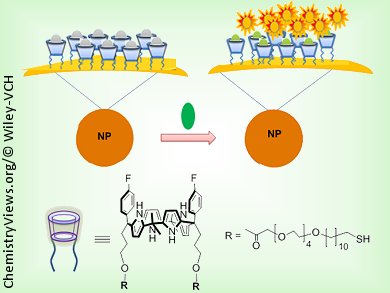Owing to the toxicity of the fluoride anion, the development of a sensor to detect this species is of great interest. Indeed, the importance of anions in a wide range of chemical and biological processes, including sensing, extraction, and catalysis, have encouraged intensive research in the area of anion recognition chemistry. The collaboration between the groups of Jonathan L. Sessler, University of Texas at Austin, USA, and Chang-Hee Lee, Kangwon National University, South Korea, has focused on the development of chemosensors for fluoride ions. They have succeed in the synthesis of calix[4]pyrrole-functionalized Au nanoparticles (NPs), so-called nanoreceptors with an average diameter of about 4 nm, that permit the sensitive recognition of fluoride anions in organic media.
The system shows both a chromogenic and a “turn-on” fluorogenic response upon exposure to tetra-n-butylammonium fluoride (TBAF). Moreover, it does so with a level of sensitivity that is greatly enhanced relative to the corresponding monomeric receptor, that is, the calix[4]pyrrole. In addition, under biphasic aqueous-organic conditions, the sensor acts as an effective extractant for TBAF. As these nanoreceptors show a potential for recognition, sensing, and extraction, it is envisaged that they may also play a role in various practical applications in which the effective and selective binding of the fluoride anion is required.
- Decoration of Gold Nanoparticles by a Double-Armed Calix[4]pyrrole: A Receptor-Decorated Nanoensemble for Anion Sensing and Extraction,
Punidha Sokkalingam, Seong-Jin Hong, Abdullah Aydogan, Jonathan L. Sessler, Chang-Hee Lee,
Chem. Eur. J. 2013.
DOI: 10.1002/chem.201300472




